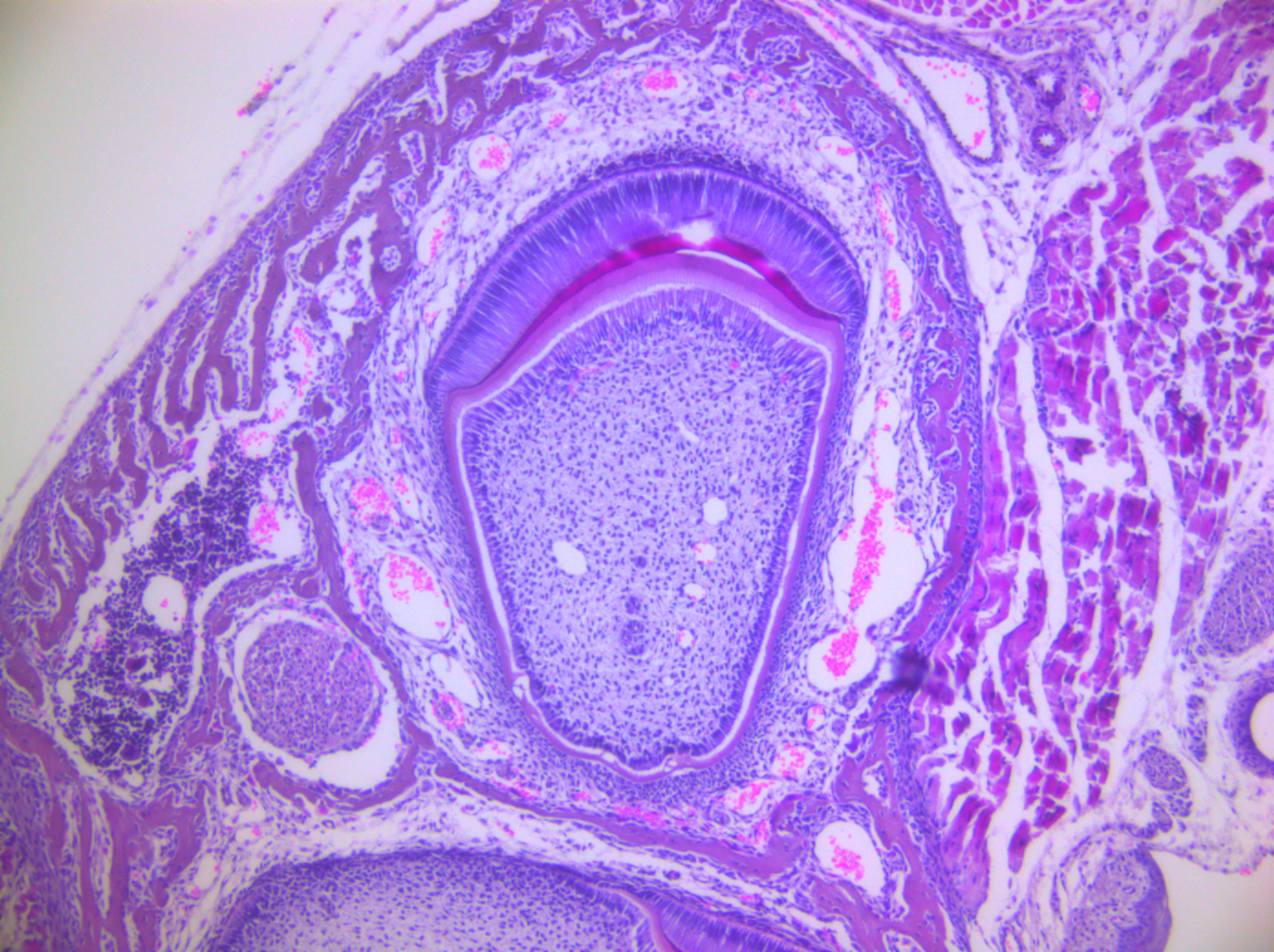Immunohistochemical localization of transient receptor potential vanilloid-type 5 in ameloblasts of Swiss mice
Localización inmunohistoquímica de receptores de potencial transitorio tipo vaniloide 5 en ameloblastos de ratones Swiss


This work is licensed under a Creative Commons Attribution-NonCommercial-ShareAlike 4.0 International License.
Show authors biography
Objective. To determine the localization of transient receptor potential vanilloid 5 (TRPV5) in the ameloblasts of Swiss mice. Materials and methods. In vitro experimental study where paraffin sections of 12 continuously growing incisors of 7-day-old male Swiss mice were analyzed. Developmental stages of dental enamel formation were identified by hematoxylin-eosin staining. Immunodetection of the transient receptor potential vanilloid 5 was performed using the primary polyclonal antibody anti-TRPV5. Observations were carried out using a Leica DM 500 microscope. Results. The different stages involved in the formation of dental enamel were identified, including the secretory and maturation stages. In them, it was evidenced that the ameloblasts were elongated cells with oval nuclei in a proximal position and with developed areas of medial and distal secretion. TRPV5 immunolabeling was visualized in the cell membrane and cytoplasm of the secretory and maturation ameloblasts of all mice tested. TRPV5s were also immunolocalized in odontoblasts, vascular endothelium, and pulp cells. Conclusions. The transient receptor potential vanilloid 5 is located on the secretory and maturing ameloblasts of Swiss mice. In particular, TRPV5s are immunodetected in odontoblasts, vascular endothelium, and dental pulp cells.
Article visits 599 | PDF visits
Downloads
- Thompson VP. The tooth: An analogue for biomimetic materials design and processing. Dent Mater. 2020; 36(1):25-42. https://doi.org/10.1016/j.dental.2019.08.106
- Bronckers AL. Ion Transport by Ameloblasts during Amelogenesis. J Dent Res. 2017; 96(3):243-253. https://doi.org/10.1177/0022034516681768
- Eckstein M, Aulestia FJ, Nurbaeva MK, Lacruz RS. Altered Ca2+ signaling in enamelopathies. Biochim Biophys Acta Mol Cell Res. 2018; 1865(11 Pt B):1778-1785. https://doi.org/10.1016/j.bbamcr.2018.04.013
- Kim HE, Hong JH. The overview of channels, transporters, and calcium signaling molecules during amelogenesis. Arch Oral Biol. 2018; 93:47-55. https://doi.org/10.1016/j.archoralbio.2018.05.014
- Simmer JP, Papagerakis P, Smith CE, Fisher DC, Rountrey AN, Zheng L, Hu JC. Regulation of dental enamel shape and hardness. J Dent Res. 2010; 89(10):1024-38. https://doi.org/10.1177/0022034510375829
- Peng JB, Suzuki Y, Gyimesi G, Hediger MA. TRPV5 and TRPV6 Calcium-Selective Channels. In: Kozak JA, Putney JW Jr, editors. Calcium Entry Channels in Non-Excitable Cells. Boca Raton (FL): CRC Press/Taylor & Francis; 2018. https://doi.org/10.1201/9781315152592-13
- Simancas-Escorcia V, Guarapo AEN, Camargo MGA de. Genes involucrados en la amelogénesis imperfecta. Parte I. Rev Fac Odontol Univ Antioq. 2018; 30(1):105-120. https://dx.doi.org/10.17533/udea.rfo.v30n1a10
- National Research Council (US) Committee for the Update of the Guide for the Care and Use of Laboratory Animals. Guide for the Care and Use of Laboratory Animals. 8th edition. Washington (DC): National Academies Press (US); 2011. https://doi.org/10.17226/12910
- Na T, Peng JB. TRPV5: a Ca(2+) channel for the fine-tuning of Ca(2+) reabsorption. Handb Exp Pharmacol. 2014; 222:321-357. https://doi.org/10.1007/978-3-642-54215-2_13
- So CL, Milevskiy MJG, Monteith GR. Transient receptor potential cation channel subfamily V and breast cancer. Lab Invest. 2020; 100(2):199-206. https://doi.org/10.1038/s41374-019-0348-0
- Robertson SYT, Wen X, Yin K, Chen J, Smith CE, Paine ML. Multiple Calcium Export Exchangers and Pumps Are a Prominent Feature of Enamel Organ Cells. Front Physiol. 2017; 8:336. https://doi.org/10.3389/fphys.2017.00336
- Harada H, Otsu K. Microdissection and Isolation of Mouse Dental Epithelial Cells of Continuously Growing Mouse Incisors. Methods Mol Biol. 2019; 1922:3-11. https://doi.org/10.1007/978-1-4939-9012-2_1
- Ida-Yonemochi H, Otsu K, Harada H, Ohshima H. Functional Expression of Sodium-Dependent Glucose Transporter in Amelogenesis. J Dent Res. 2020; 99(8):977-986. https://doi.org/10.1177/0022034520916130
- Eckstein M, Lacruz RS. CRAC channels in dental enamel cells. Cell Calcium. 2018; 75:14-20. https://doi.org/10.1016/j.ceca.2018.07.012
- Simancas-Escorcia V, Berdal A, Díaz-Caballero A. Caracterización fenotípica del síndrome amelogénesis imperfecta–nefrocalcinosis: una revisión. Duazary. 2019; 16(1):129. https://doi.org/10.21676/2389783X.2531
- Van der Wijst J, van Goor MK, Schreuder MF, Hoenderop JG. TRPV5 in renal tubular calcium handling and its potential relevance for nephrolithiasis. Kidney Int. 2019; 96(6):1283-1291. https://doi.org/10.1016/j.kint.2019.05.029
- Nie M, Bal MS, Yang Z, Liu J, Rivera C, Wenzel A, Beck BB, Sakhaee K, Marciano DK, Wolf MT. Mucin-1 Increases Renal TRPV5 Activity In Vitro, and Urinary Level Associates with Calcium Nephrolithiasis in Patients. J Am Soc Nephrol. 2016; 27(11):3447-3458. https://doi.org/10.1681/ASN.2015101100
- Diaz Rojas KA, Simancas-Escorcia V. Caracterización fenotípica del Síndrome de Raine. Cienc Salud Virtual. 2019; 11(2):131–142. https://doi.org/10.22519/21455333.1267
- Simancas-Escorcia VH, Natera-Guarapo AE, Acosta de Camargo MG. Genes involucrados en la Amelogénesis Imperfecta. Parte II. Rev Fac Odontol Univ Antioquia. 2019; 30(2). https://doi.org/10.17533/udea.rfo.v30n2a9
- Hossain MZ, Bakri MM, Yahya F, Ando H, Unno S, Kitagawa J. The Role of Transient Receptor Potential (TRP) Channels in the Transduction of Dental Pain. Int J Mol Sci. 2019; 20(3):526. https://doi.org/10.3390/ijms20030526
- Simancas-Escorcia VH. Fisiopatología de los odontoblastos: una revisión. Duazary. 2019; 16(3):87–103. https://doi.org/10.21676/2389783X.2971
- Cho YS, Ryu CH, Won JH, Vang H, Oh SB, Ro JY, Bae YC. Rat odontoblasts may use glutamate to signal dentin injury. Neuroscience. 2016; 335:54-63. https://doi.org/10.1016/j.neuroscience.2016.08.029
- Kim JH, Won J, Oh SB. Expression of CaV3.1 T-type Calcium Channels in Acutely Isolated Adult Rat Odontoblasts. Arch Oral Biol. 2020; 118:104864. https://doi.org/10.1016/j.archoralbio.2020.104864
- Baylie RL, Brayden JE. TRPV channels and vascular function. Acta Physiol (Oxf). 2011; 203(1):99-116. https://doi.org/10.1111/j.1748-1716.2010.02217.x























